Lauterbrunnen Valley Facts
- Simply put, the term of Lauterbrunnen Valley names one of the most visually stunning natural formations found anywhere on earth. Its very name provides insight into its physical nature. Roughly translated, the given appellation means many fountains.
- It represents a truly magnificent example of what’s called a cleft valley. It’s situated in an area of the world itself already well known for its surpassing natural splendor. The magnificent site also remains famous for more than just the extent of its beauty.
- That’s because this simultaneously gorgeous, yet rugged-looking, valley also has a quite surprising shape to it. In point of fact, it developed a rough U-shape that runs south-southwest. The shaping of this wonder by natural forces took much time.
- Even more natural marvels wait to greet the eyes of its visitors. This holds true due to the fact that numerous streams, both large and small, create a wonderland. Formed by melting glaciers, these create a total of 72 waterfalls in Lauterbrunnen Valley.
- This location holds still one more claim to fame. That’s because the site also has an ancient history. The location was first mentioned in literature as early as the year 1240. The translation of original text gives it another name translating as clear spring.
Related Articles
Lauterbrunnen Valley Physical Description
Perhaps most notably, the absolutely magnificent site known as Lauterbruunen Valley proves the concept that size bears no relation to beauty. That’s because the location ranks as a moderate-sized valley. Nature, however, places absolutely no importance on such things.
To be more precise, the location measures roughly 5 mi (8 km) in length. While its width varies, it rarely exceeds 0.62 mi (1 km) in width. However, this work of Nature does stand out from related features in its general part of the world in one physical measurement.
That’s due to the impressive fact that the breathtaking valley has a depth that exceeds more than 1,000 ft (305 m) over the majority of its total length. That remarkable measurement makes it one of the deepest such features to be found in the region in which it formed.
But the distinctiveness of the astounding Lauterbrunnen Valley does not simply end with these facts. That statement holds true due to a rare combination of factors. These include the facts of its own physical depth, and its many marvelous surrounding features.
This occurs because of part of the natural design of the dazzling gorge. Its almost perfectly vertical walls formed as, and continue to be, closely surrounded by high mountains. Combined with the depth of the canyon, it makes for a striking visual image.
Lauterbrunnen Valley Location, Geology, and Ecology
The mind-blowing wonder that we name Lauterbrunnen Valley formed long ago in an already stunning region well known for its marvels. That’s because the magnificent canyon formed in what now constitutes a specific portion of the beautiful continent of Europe.
There, its creation placed it in the general eastern regions of the landmass. It originated as part of the greater development of the Alps via the collision of the African and European Plates. Even more precisely, it formed near what is currently the city of Bern, Switzerland.
The incredible geology of the remarkable valley includes numerous waterfalls. Perhaps the best known of these amazing cascades bears the name of Staubback Falls. The Falls drop nearly 900 ft (270 m) in total and form one of the highest unbroken waterfalls in Europe.
Astonishingly, approximately 16% of the valley still remains covered by a glacier. This only serves to further add to its amazing splendor. The water forming the waterfalls understandably comes from the massive amounts of melting snow from the mountains.
As a result of this, the water from this region remains famous for its purity. Our listing of the marvels of the visually stunning Lauterbrunnen Valley continue, though. That’s true because the site additionally comprises a total area of about 63.5 sq mi (164.5 sq km).
Of this greater area, a remarkable total of 51% continues to either have a covering of forest or be used by humans for agricultural purposes. As a result of both situations, this wonderful location plays an important role in the area in which it formed, even today.
Features Sharing Its Region
Check out our other articles on Magnificent Mammals of Australia, Milford Sound, Scythian Lamb, Pygmy Rabbit, Black and Yellow Mud Dauber, Tiger Shark, Alligator Snapping Turtle

